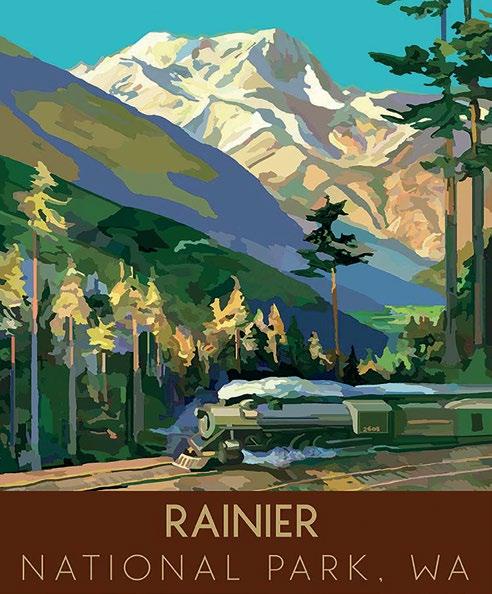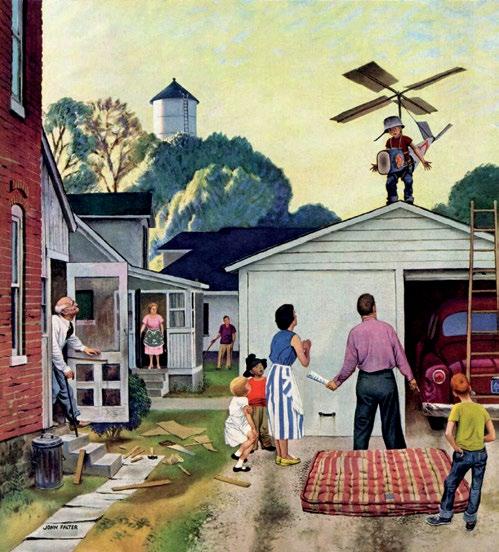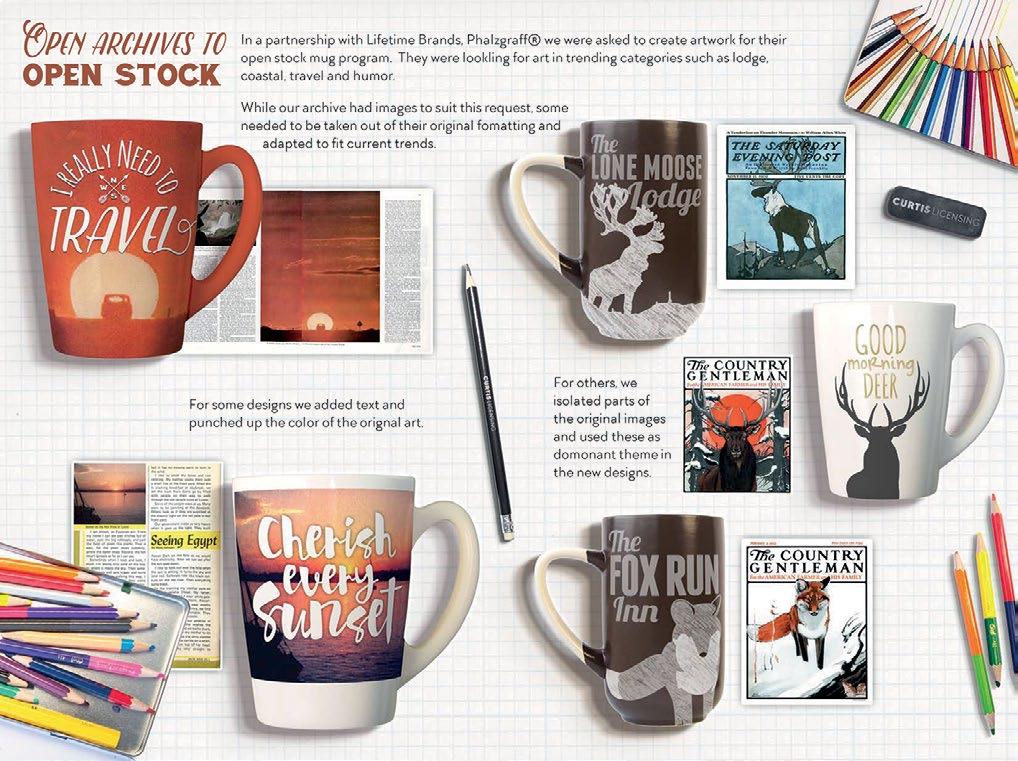
7 minute read
Creating a Sustainable Program
How we created a sustainable licensing program from a 200 year old magazine
By Cris Piquinela, Director of Licensing at Curtis Licensing
The name The Saturday Evening Post usually conjures images of classic Americana. Idyllic small town images, happy families enjoying the simple and worriless life, the glowing expectant faces of children waiting for Santa on Christmas Eve and of course, there is Norman Rockwell. No other artist has ever been more celebrated for his sentimental, and often humorous portrayals of American life than Rockwell. Whether you grew up reading The Saturday Evening Post or are completely unfamiliar with Norman Rockwell, when presented with the classic illustrations that made the magazine famous, most people feel a clear connection to them. But how do you translate that to a viable, sustainable licensing program? When I joined SEP, the bulk of the licensing agreements were driven by the Norman Rockwell covers. While there were also a good number of licensees that utilized covers by other artists such as J.C. Leyendecker, Stevan Dohanos and John Falter, the offerings were heavily skewed towards Norman Rockwell, and with good reason. The man is a legend when it comes to illustration. His original works are routinely sold at auction for millions of dollars, his covers are recognized all over the world and he has generated images that are often imitated by other artists, such as the iconic
Freedom From Want image. However, as they say, you can’t put all your eggs in one basket, so in order to grow, we had to expand beyond the classics. One thing that most people don’t realize about SEP is the sheer enormity of our archive. To give some perspective, the first official issue of The Saturday Evening Post was published on August 4, 1821. As reference, James Monroe was the president of the United States at the time and that was the same year that Napoleon died! At the start, SEP was only a 4 page “broadsheet,” but by the early 1900s it had grown into a weekly magazine with over 100 pages of articles, photos, illustrations and cartoons per issue! And that only accounts for 1 magazine within the various publications included under our umbrella, which include Country Gentleman as well as various children’s publications like Jack and Jill, Playmate, Turtle, Child Life and many others. Given the huge popularity of the SEP covers, it seemed only natural to base the beginnings of our licensing program on those images. Among our first merchandise licenses in early 1960’s were prints and greeting cards in the most popular themes. Fast forward to 2009 when I started at SEP, and still the bulk of our licensing business was based on the same classic well-known images. But then two things

happened that radically changed how we did business. At the same time that our licensing division started looking into different materials to generate revenue, our Publisher, Joan SerVaas, began implementing a legacy preservation project for SEP that consisted on scanning every issue of the magazine cover to cover. This massive scanning endeavor was aimed at not only preserving the historical value of the collection, but also eventually offering the archive to consumers digitally. From a licensing perspective, this growing scans collection meant that we could now view various pages on a digital screen simultaneously, rather than physically going through the printed issues page by page looking for materials. In the years since the scanning project began, we have accrued 437,663 pages of content for The Saturday Evening Post and over 300,000 pages from our other magazines, and counting. We are also tagging the various materials which will make our future searches even more efficient and productive. Previously, it would take us days to gather a few images for any given theme…now we can gather a collection in a matter of hours. The ability to quickly view and search for images also further opened our eyes to the multitude of other content that we had at our disposal for our licensing program. Cartoons, children’s stories, poems, articles, the possibil

ities were endless. We informed our licensees about this new content, while also displaying it at tradeshows. Little by little, requests for these new materials started growing, aided by our willingness to go the extra mile and search for anything a licensee may be looking for. When foxes started trending, we looked for foxes. When mid-century Santa’s became the hot holiday look, we looked for those too. Our ability to promptly respond to trend-based requests became a key to our ongoing success and the size of our art archive tripled in no time. With a growing art collection came also a new challenge. Harvesting great content did not necessarily mean that the art was usable as is. Many illustrations only make sense in the context of the story they accompany. So, it became clear that we would need to start modifying some of the art. While art adaptation had always been part of our process (we did remove the SEP masthead from images and did cropping and modest modifications), as our content grew, our creative approach to design really took off. Flexibility had always been a core value at Curtis Licensing, not only when it came to

the terms of an agreement or program, but also with regards to the use of the art. During meetings and discussions, we would often tell licensees to crop or modify the artwork to better fit their needs. However, whether due to a lack of time or resources, or whether it was an inherent fear to “change” original artwork, a lot of companies would shy away from this. So, bit by bit, we took on this design work ourselves which was the second crucial change in how we conducted business. Looking back at some of our earlier designs, many changes were subtle, adding text here and changing a color there. But as we got more comfortable with our new role, we began taking the art to a whole new level. Nowadays, we will take a simple image and painstakingly “paint” over it with lush chunky strokes to give it a “paint by numbers” look, add verbiage and turn a simple mountain into a “Mount Rainier National Park” poster. Using a variety of techniques and tools, our designers have become experts in modifying, tailoring and even creating their own original artwork to accommodate the specific needs of our licensees. Working collectively as a team,


our executive team and designers also research the upcoming color and thematic trends and create entire collections ahead of schedule so when the requests come in, we can hit the ground running. Building a licensing program out of America’s oldest magazine has been a long fun ride…and we still have a lot of work to do! But we look at each challenge as an opportunity to grow and learn new skills. However, getting started can be a daunting process. So, my advice to anyone trying to deal with a large archive of content, regardless of the nature of the archive, would be the following: 1. Assess what you have. You can’t effectively offer or license content if you don’t really know your archive or what it contains. Spend the time to go through, organize and research your materials and make sure you own the rights to it. 2. Whenever possible, invest in a searchable database that can digitally manage your content. Scanning materials takes time and effort, but it will make things much easier and more productive later on. 3. Be open to change. It is easy to view a 200 year old collection almost as a “museum piece” that must remain intact or untouched. However, with today’s ever changing market trends and the need to always offer something fresh, it is difficult to survive long term if you are not somewhat willing to adapt. 4. Live and love your content. Nobody will advocate for your collection as well as you. Know the history, learn the artists, study the content. We love our Saturday Evening Post magazine and its amazing materials and that love is what motivates us to constantly work harder and better at making our licensing program a success.










